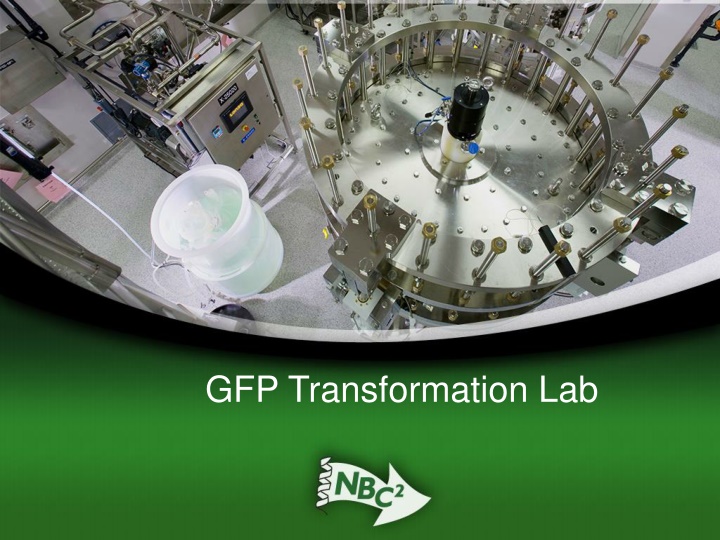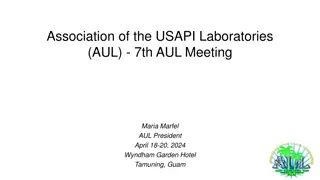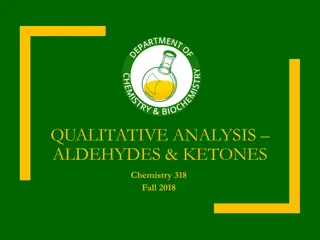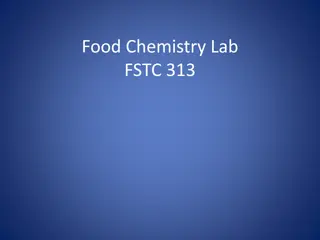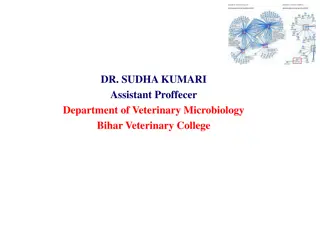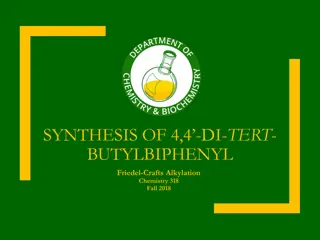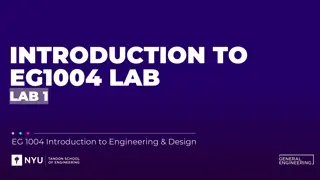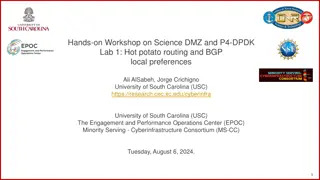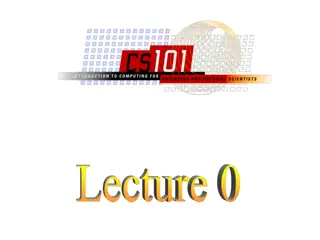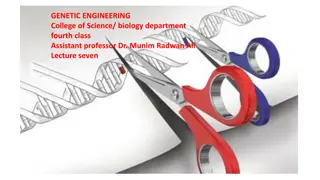GFP Transformation Lab
In this lab experiment, students will demonstrate the central framework of molecular biology by transforming bacteria into glowing colonies. They will select for transformed cells using antibiotic resistance and study operon control over pGLO protein production. Additionally, they will explore the structure of the GFP protein and detect gene activity through the insertion of the PGLO gene. The overall goal is to use genetic engineering techniques to insert the GFP gene into E. coli, with a focus on biomanufacturing. The GFP (Green Fluorescent Protein) is naturally produced in Jellyfish and acts as a reporter gene linked to another gene, producing a glowing protein when expressed. This immersive experience aims to engage students in practical biotechnology applications and enhance their understanding of genetic engineering processes.
Download Presentation

Please find below an Image/Link to download the presentation.
The content on the website is provided AS IS for your information and personal use only. It may not be sold, licensed, or shared on other websites without obtaining consent from the author.If you encounter any issues during the download, it is possible that the publisher has removed the file from their server.
You are allowed to download the files provided on this website for personal or commercial use, subject to the condition that they are used lawfully. All files are the property of their respective owners.
The content on the website is provided AS IS for your information and personal use only. It may not be sold, licensed, or shared on other websites without obtaining consent from the author.
E N D
Presentation Transcript
GFP Transformation Lab Images taken without permission from http://upload.wikimedia.org/wikipedia/de/4/4d/Protein_GFP_1EMA.png, http://bioinfo.biotec.or.th/Picture/Cell%20Tutorial/image005.jpg, http://www.plantsci.cam.ac.uk/Haseloff/SITEGRAPHICS/Jellyfish.jpeg
Bring Biotechnology to your Classroom Demonstrate the central framework of molecular biology Transform bacteria into glowing colonies Select for transformed Cells by antibiotic resistance View operon control over pGLO protein production Introduction to Biomanufacturing
GFP (Green Fluorescent Protein) Naturally produced in Jellyfish Aequorea victoria Discovered in 1960 s Source of bioluminescence when exposed to UV light Img Src: http://icbxs.ethz.ch/members/leu/jellyfish.gif , http://www.plantsci.cam.ac.uk/Haseloff/SITEGRAPHICS/Jellyfish.jpeg
Structure of the GFP Protein Img Src: http://wwwchem.leidenuniv.nl/metprot/armand/images/029l.jpg
Detecting Gene Activity PGLO gene is inserted into DNA near a gene of interest It acts as a reporter gene - linked to another gene & glowing protein appears if it is expressed Expressed in entire animals Img Src: http://www.bio.umass.edu/microscopy/images/gfp.jpg Img Src: http://www.mshri.on.ca/nagy/graphics/GFP%20mic e.jpg Img Src: http://www.computerra.ru/pubimages/73944.jpg Img Src: http://www.antville.org/img/pop/gfp.jpg
pGLO plasmid 3 genes of interest: GFP gene Codes for the GFP protein Bla gene Codes for the enzyme -lactamase -lactamase destroys the antibiotic ampicillin araC regulator protein Controls expression of GFP
Overall Goal of Lab Experiment Use genetic engineering techniques to insert the GFP gene into E. coli Plasmid containing gene of interest Protein to be produced
Selecting for Transformed Cells Selectable Marker: Trait that helps identify a transformed cell by conferring resistance to ampicillin Ampicillin presence in LBAgar will kill wild type E.coli BUT Transformed E. coli survive in the presence of ampicillin in LB Agar Transformed E.coli ampicillin Images taken without permission from http://www.antibioresistance.be/Gifs_Ant/blue2.gif and http://www.antibioticos.it/images/formule%20chimiche/ampicillin.gif
Arabinose Operon The arabinose operon in bacteria consists of the following: Usually, the araC protein binds to the arabinose operon operator prevents transcription When arabinose is present, it binds to the araC protein -> can t bind to operator RNA polymerase can continue
Scientists modified the arabinose operon in pGLO to express the GFP gene. araC protein binds to the operator prevents transcription When arabinose binds to araC it can no longer bind to operator GFP gene is transcribed and translated
Central Dogma of Molecular Biology
Controls Spread E. coli without plasmid (- DNA) on plain LB agar Wild type E. coli can grow demonstrated Spread E. coli without plasmid (- DNA) on LB/amp E. coli aren t already resistant to ampicillin
Transformation Yields Product What does this lead to? Ability to produce a protein we need but can't make Cell acts as the factory for the product under the correct conditions Increased cell number yields increased product
Transformation Procedure Step 1 Prepare appropriate plates Step 2 Suspend cells in CaCl2 solution Step 3 Add pGLO plasmid to cells/put onto ice Step 4 Heat Shock at 42oC /put onto ice Step 5 Add nutrient broth to cells Step 6 Streak cells on to appropriate plates
Transformation Time Line First step: Grow up colonies of E.coli Second step: Prepare Selective media Transform cells with pGLO plasmid Detect transformed cells 2-3 days required 1 day 45 minutes Results in 24 hours Supplies for up to 32 students
PGLO Transformed E.coli Cells containing pGLO plasmid are now resistant to ampicillin Cells containing pGLO plasmid will also glow green when arabinose
Biomanufacturing Upstream Processing: Growing genetically transformed cells that produce a desired protein Downstream Processing: Separation and purification of that product for human use
